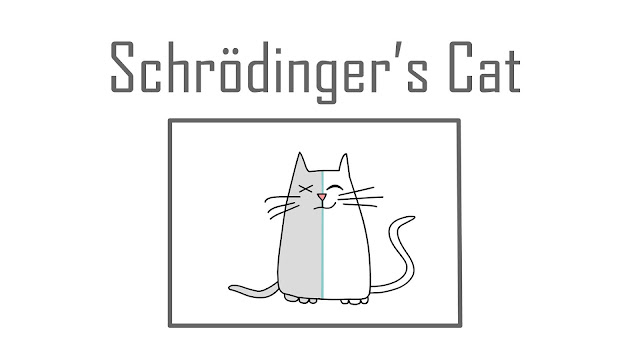<Picture 1 ; Shrodinger's Cat>
In the last post, we talked about the Blackbody Radiation. Under the classical physics, Rayleigh and Jeans studied the blackbody radiation and they made an equation. But it wasn't identical to the experimental data. So, Planck fixed the equation and opened the door of quantum mechanics.
Today's topic is the Schrodinger's cat. Schrodinger, a famous physicist in Austria, used a cat for a thought experiment of quantum mechanics metaphorically. In the experiment, the cat is both dead and alive at the same time. It might be awkward that she is both dead and alive simultaneously. Let's figure out what he tried to say.
1. Double Slit Experiment
<Picture 2 ; Double Slits Experiment - Particle>
Suppose that there are two slits on the wall. If I shoot the gun through the wall, some of the bullets will pass through the slits and the others will be stuck on the wall.
In Picture 2, the graph P_1 shows the probability distribution for bullets which passed through the first slit. If you block the second slit and shoot the gun, then the graph P_1 will be drawn. The graph P_2 shows the probability distribution for bullets through second slit. If you block the first slit and shoot the gun, then the graph P_2 will be drawn. The graph P_12 shows the probability distribution for bullets through the both slits. If you open all slits and shoot the gun, then the graph P_12 will be drawn.
It was an experiment for the particle. The bullets are example of particle. In conclusion, the graph P_12 is the sum of P_1 and P_2. In addition, each particles from the first slit and the second slit doesn't make an interference.
<Picture 3 ; Double Slits Experiment - Wave>
Now here is an experiment for the wave. Suppose that there is a pond and we will drop a pebble on it. If you block the second slit and drop the pebble, the graph I_1 will be drawn. Meanwhile, if you block the first slit and drop the pebble, the graph I_2 will be drawn. But if you open all slits and drop the pebble, the waves will interfere each others and the graph I_12 will be drawn.
<Picture 4 ; Double Slits Experiment - Electron>
What about electrons? Are they particles or waves? If you experiment with an electrons, they interfere each others. So, they act like waves.
But I want to know which slit an electron passed through. So if I set the camera and light source in front of the wall, the interference pattern will disappear. They act like a particle. So, what is going on? Are they particles or waves? Conclusively, they are both particles and waves. An electron has a property of both particle and waves.
Why did this happen? It's because of the light source. In our daily life, a ball's movement, for example, is not affected by the light because the mass of ball is too heavy to be affected. But electron is a tiny tiny matter. So its movement can be affected by the light. Therefore, if you set the camera and light source in front of the wall, they will affect the movement of electrons.
Then how about turning the light off? The picture taken by camera will be just black. Then how about turning on the light with less intensity? The answer is on the uncertainty principle.
2. Uncertainty Principle
<Picture 5 ; Werner Heisenberg>
The uncertainty principle, which was discovered by Werner Heisenberg in 1927, is that it is impossible to know both the exact position and exact momentum of an object at the same time. Its simple mathematical form is as follows.
Delta x is the amount of position variation and delta p is the amount of momentum variation. In addition, h is Planck constant.
Back to the double slit experiment, if you turn on the light with less intensity, delta p will increase because intensity is inversely proportional to momentum. It means that the uncertainty of momentum increased. Meanwhile, if you turn on the light with more intensity, delta p will decrease and delta x will increase. So, the uncertainty of position increased.
According to the uncertainty principle, it is impossible to know both the exact position and exact momentum simultaneously. The only one we know is the probability. Conclusively, quantum mechanic is a theory of probability.
3. Shrodinger's Cat
<Picture 6 ; Shrodinger's Cat>
Schrodinger's cat is a thought experiment devised by Austrian physicist Erwin Schrodinger in 1935. At first, he devised it to criticize the probabilistic interpretation of quantum mechanics(Copenhagen Interpretation). But nowaday it is used to explain the quantum mechanics.
Suppose that a cat, a flask of poison, and a radioactive source are placed in a sealed box. If an internal monitor detects radioactivity, the flask will be shattered, releasing the poison that kills the cat.
According to the Copenhagen Interpretation, the radioactivity will be detected probably. So, the monitor may and may not detect the radioactivity. In addition, the poison may and may not be released. Therefore, the cat is both dead and alive simultaneously until someone open the box. This is the superposition. If someone open the box, he will be able to know whether the cat is alive or dead. But until the box is opened, the cat is under the superposition.
Did you understand this weird interpretation? May be and may be not. Actually, this idea confused (not only you but) many physicists and philosophers including Einstein and Niels Bohr. In the next post, we're gonna talk about the biggest match in 20C between Einstein and Niels Bohr, God and dice. Thank you for reading it. See you in the next post.
Bibiology
Richard P. Feynman, Robert B. Leighton, Matthew Sands, 1965, 「The Feynman lectures on physics」, Addison-Wesley Pub. Co.
Arther Baiser, 2003, 「Concepts of Modern Physics(6th ed.)」, Boston : Mcgraw-Hill.
https://en.wikipedia.org/wiki/Schr%C3%B6dinger%27s_cat
2016.05.07. Hankwanghee









댓글
댓글 쓰기